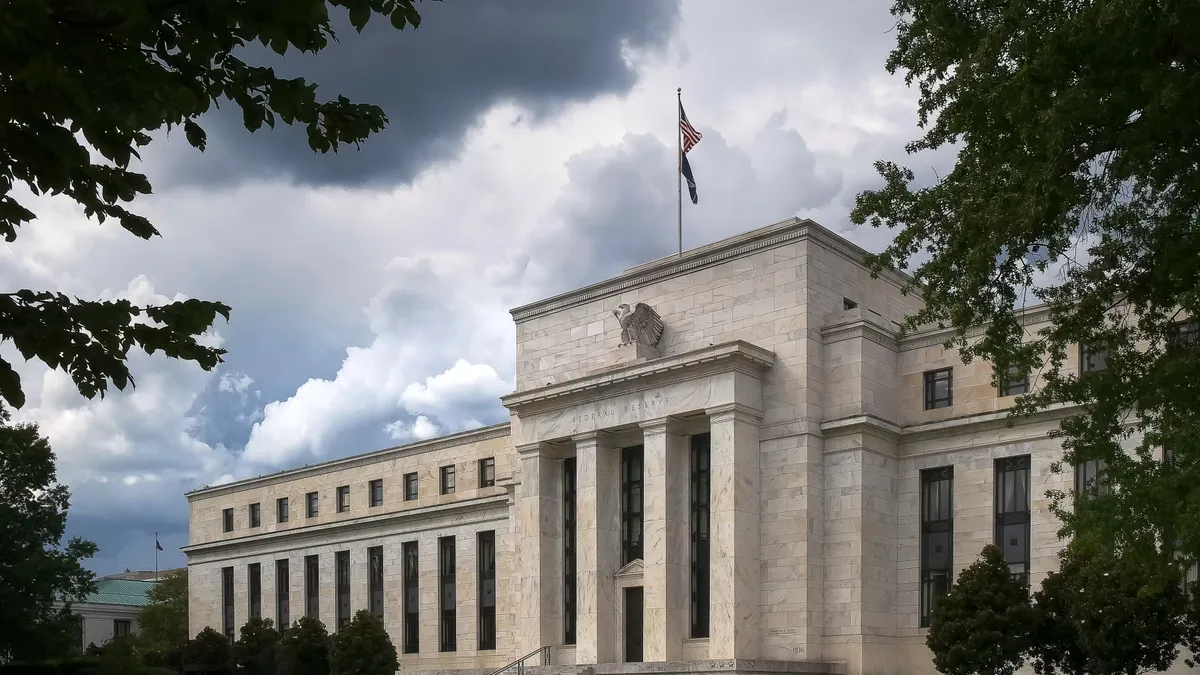Dive Brief:
- Federal Reserve Chair Jerome Powell signaled Wednesday that the central bank in December will likely slow the pace of its increases in the federal funds rate while suggesting that monetary policy may ultimately end up more restrictive than Fed officials earlier estimated.
- “We anticipate that ongoing increases will be appropriate” beyond the current 3.75% to 4% range in the main interest rate, Powell said in a speech at the Brookings Institution. “It seems to me likely that the ultimate level of rates will need to be somewhat higher than thought at the time of the September meeting,” he said. That month, most Fed officials saw the benchmark interest rate rising early next year to a 4.5% to 5% range.
- Still, Powell said, “the time for moderating the pace of rate increases may come as soon as the December meeting,” noting some signs of easing price pressures and that a tightening in monetary policy takes time to show up in the economy.
Dive Insight:
Powell noted a few gains in the Fed’s most aggressive fight against inflation since the 1980s, including an improvement in supply chain disruptions and a cooling in the housing market.
Nevertheless, “inflation remains too high,” he said, pledging that the central bank will “stay the course” until reducing inflation to its 2% target.
Powell spoke just hours after the release of data indicating that Fed increases in the benchmark interest rate — totaling 3.75 percentage points this year — have yet to significantly cool the job market and broader economy.
U.S. gross domestic product during the third quarter increased at an annual rate of 2.9%, the Commerce Department said Wednesday, revising its earlier estimate of 2.6% growth. Moreover, job openings in October totaled 10.3 million, well beyond the 6.1 million unemployed people looking for work, the Labor Department said Wednesday.
“So far, we have seen only tentative signs of moderation of labor demand,” Powell said, adding “wage growth remains well above levels that would be consistent with 2% inflation over time.
“Despite some promising developments, we have a long way to go in restoring price stability,” he said.
Since their Nov. 1-2 meeting, Fed policymakers have signaled that they plan to slow the pace of increases in the main interest rate to a half point at their Dec. 13-14 gathering. At the same time, they have said they may increase the benchmark interest rate over time to a level that exceeds their earlier projections.
“Stronger demand for labor, stronger demand in the economy than I previously thought and then somewhat higher underlying inflation suggest a modestly higher path for policy relative to September,” New York Fed President John Williams said Monday, according to Bloomberg. “Not a massive change, but somewhat higher.”
St. Louis Fed President James Bullard believes that policymakers will need to increase the main interest rate to at least 4.9% in order to reduce inflation to their 2% target, or 1.4 percentage points higher than his estimate in the spring, he said in a note posted on the district bank’s website on Tuesday.
Powell raised the prospect that the Fed may cool the economy and slow inflation without causing a recession, noting that a decline in the high number of job openings could buffer against a severe fall in employment.
“There’s a possibility that in this highly unusual situation the labor market could come back into balance to some extent through a decline in job openings,” Powell said after his speech in response to questions.
The Fed may need in coming years to adjust monetary policy to an unusual level of “supply shocks” threatening price stability, according to Fed Vice Chair Lael Brainard.
“A protracted series of adverse supply shocks could persistently weigh on potential output or could risk pushing inflation expectations above target in ways that call for monetary policy to tighten for risk-management reasons,” Brainard said in a speech Monday, citing the disruptions from the pandemic and Russia’s invasion of Ukraine.
“It is possible that longer-term changes – such as those associated with labor supply, deglobalization and climate change – could reduce the elasticity of supply and increase inflation volatility in the future,” Brainard said.
Powell said Wednesday he shared Brainard’s concern, noting “the question is, what is the new normal going to be?”
“Are we going to have a situation a little bit like the 1970s, where there will be repeated, ongoing shocks, and which would tend to put more upward pressure on inflation over time?” he said. “We don't really know.”












